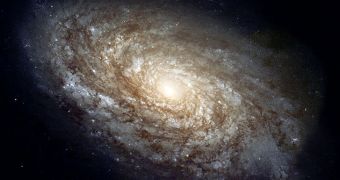Over the past few years, astronomers surveying the skies noticed that the brightest, most massive galaxies appeared to be occupying only specific regions of the Universe. The correlation was strongest for older cluster, some up to 10 billion years old. Puzzled by this trend, an international group of researchers decided to investigate the phenomenon. Also part of the study was a team of astronomers from the University of California in Irvine (UCI), led by expert Asantha Cooray. The group found out that these bright galaxies, which appear to be forming stars at impressive rates, tend to prefer regions of the Universe that are very rich in dark matter.
Actually, the thing that captured the attention of investigators more was the fact that these cosmic structures appeared to be producing vast amounts of young, blue stars, much more so than galaxies in other parts of the Cosmos. Using the European Space Agency's (ESA) Herschel Space Observatory, the group created a map of the distribution of galaxies, as they appeared in the sky 10 billion years ago. One of the conclusions the group drew from its study was the fact that the massive rate of stellar formation may have been triggered and supported by numerous collisions, in these crowded regions.
“Thanks to the superb resolution and sensitivity of the SPIRE [Spectral & Photometric Imaging Receiver] instrument on Herschel, we managed to map in detail the spatial distribution of massively star-forming galaxies in the early universe. All indications are that these galaxies are […] crashing, merging and possibly settling down at centers of large dark-matter halos,” says Cooray. The expert is an associate professor at UCI, and also the Chancellor’s Fellow in physics & astronomy. Due to this investigation, conventional theories of galaxy formation may need to be slightly adapted.
“It’s just the kind of thing we were hoping for from Herschel, and was only possible because we can see so many thousands of galaxies. It will certainly give the theoreticians something to chew over,” adds the leader of the new survey, University of Sussex professor Seb Oliver. The group now plans to publish its discoveries in an upcoming special issue of the esteemed scientific journal Astronomy & Astrophysics, which will deal exclusively with findings made with the 1-year-old Herschel telescope.

 14 DAY TRIAL //
14 DAY TRIAL //